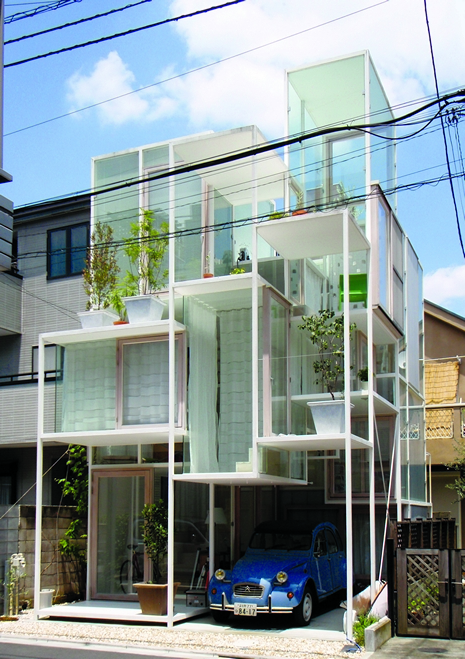Description
This project description is an excerpt from the longer article “Infill and Puntal Interventions”. For a comparative analysis and further data on this and all other categories including accompanying graphs, please see the article “A Turning Point”.
If the two projects by Atelier Bow-Wow project a sense of distinction between the public and private realms in terms of how the houses relate to the street, then House NA by Sou Fujimoto, completed in 2010, arguably represents their antithesis, blurring the boundaries between outside/inside, public and private. Constructed on a 54.47-square-meter site in the quiet neighborhood of Suginami, this three-dimensional matrix of suspended glass boxes stands as a daring, unconventional take on the kyōshō jūtaku. To presume that it was intended as an exhibitionist piece, however, misses its attempt to engage with its environment through the play on transparency. Designed for a working couple in their forties, the house was conceived of as a tree, with the functional spaces extended out from the trunk like branches. According to Fujimoto, this tree is thus akin to “a large single room” devoid of any walls and composed instead of 21 individual floor plates or branches that are situated at various heights, allowing the clients to “live like nomads within their own home”.[1]
The floating plates are arranged in such a way as to allow for free movement through the loosely defined programs of the house, akin to the tatami mats used in traditional Japanese houses in rooms that assumed a range of functions depending on the time of the day or the occasion. At grade, the house is entered through a foyer that branches down towards the guest room, and up towards the kitchen and an attached dining area. The rest of the second floor is composed of different-sized plates to accommodate various living areas, including an adjacent loft floor that is raised, doubling up as a work space when one is seated or perched on the lower branches of the living area. Ascending further up, one finds the library which is adjoined to the master bedroom and the dressing room, before culminating in the bathroom right at the very top of this volumetric assemblage. In-floor heating is installed in some of the horizontal platforms, while electrical outlets are discreetly concealed in the main areas, with other utility areas such as the heating, ventilation, air conditioning, plumbing, and storage located at the rear end of the house. In keeping with the sense of lightness imbued by the extensive use of glazing and the disaggregated floor plates, Fujimoto connected these pieces together with a white, steel-frame structure with bracings no more than 55 millimeters in width. The cool, minimalistic composition is softened by potted plants placed on the multi-level terraces, as well as the use of wood paneling framing the doors and windows. Despite the project’s transparency and openness, this vertical transition from public to intimate spaces reflects an implicit desire to preserve some semblance of privacy. Both in the day and at night, drawn curtains serve as temporary partitions but also as screens defining the personal realm of the household. When the delightful glass boxes are fully revealed, inhabitants are afforded views out to the surroundings while seated within this contemporary interpretation of the Japanese house and the urban landscape beyond, symbolizing a co-existence between architecture and the city, nature and artificiality.[2]
Sou Fujimoto, “Sou Fujimoto: House NA, Tokyo, Japan,” GA Houses 121 (May 2011): 146; “House NA/ Sou Fujimoto Architects,” archdaily, accessed November 16, 2013, http://www.archdaily.com/230533/house-na-sou-fujimoto-architects/
Fujimoto, “Sou Fujimoto: House NA, Tokyo, Japan,” 146.
 Exterior view
Exterior view
 Interior view
Interior view